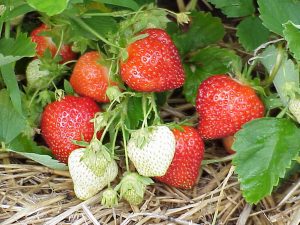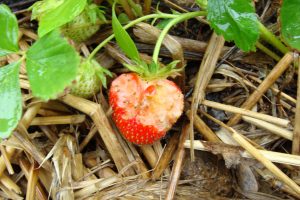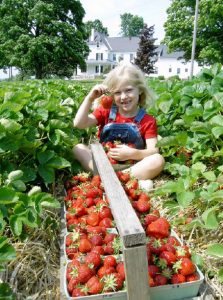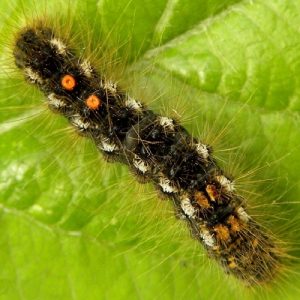Strawberry IPM Newsletter No. 5 – June 21, 2019

Strawberry IPM Newsletter No. 5 – June 21, 2019
Click on photos to enlarge.
HARVEST UNDERWAY IN SOUTHERN FIELDS
Insect Pressure Low, But Disease Pressure High
Situation:
We continue to have a mostly cool, wet weather pattern, interrupted by an occasional sunny warm day or two. But harvest is finally getting underway in some fields in southern Maine, with more planning to open this weekend. Strawberries that were under row covers and/or grown on black plastic mulch have been the earliest to ripen. Most fields have green fruit, but there are still blossoms on later varieties as you move north. Hopefully, a late start to the season will bring more customers out on opening day, because they’ve had to wait a little longer for their local berries this spring.
Strawberry bud weevil or “clipper”: Fields in southern Maine are beyond the development stage where clipper can cause significant damage. If there are still buds apparent in late fields in the north, they should be monitored for clipper injury until most of the flower buds have opened. Remember that clipper will move into raspberries and blackberries to lay eggs and clip buds once the strawberry flowers have opened.
Tarnished plant bug activity is relatively light for this point in the season. Nymphs were scattered and mostly under threshold this week. Only two fields in Limington and Monmouth were over the control threshold of more than 4 flower clusters out of 30 sampled being infested. Tarnished plant bug can still cause fruit damage after petal fall, so continue to scout for nymphs until the berries have begun to swell.
Two-spotted spider mites: Spider mite populations were very low in the fields scouted this week. No fields were over the control threshold of 25% infestation. We recommend that you keep scouting for mites up until harvest, then start scouting for them again following bed renovation in the summer.
Sap beetles: These insects may become a problem when berries start to ripen. The small, dark brown beetles chew holes in ripening fruit, similar to slug injury. They may be found in the holes they’ve chewed, but often drop to the ground when disturbed. The best management strategy for sap beetles is good sanitation. Keep the field free of overripe fruit by picking often and thoroughly. Insecticide sprays for this pest can be effective, but should be a last resort during the harvest period. Assail®, Brigade®, Dibrom® and PyGanic® are registered for control of sap beetles with pre-harvest intervals ranging from 12 to 24 hours. Read the product label carefully for this and other application instructions and restrictions.
- Picnic Beetle (left) on strawberry and Strawberry Sap Beetle (right); photo by James Dill
- Browntail Moth (Caterpillar stage); photo by James Dill
Brown Tail Moths: Although caterpillars of this insect are not likely to feed on strawberry plants, if you have infested hardwood trees next to the strawberry fields, you should be aware that many people are very sensitive to the hairs of the caterpillars and could have allergic reactions if the hairs are carried into the field by wind. Workers and customers who may be sensitive to brown tail moth should avoid those areas of the field that may be affected. You can find good information on brown tail moths for you and your customers at the Maine Forest Service website.
Gray Mold: For those fields that still have blossoms, or just finishing petal fall, fungicide coverage to prevent gray mold is still critical, given the amount of rainfall that has occurred. Botrytis can develop rapidly under the wet conditions we’ve had this spring, so keeping the flowers and developing fruit protected should be a priority. If more than one inch of rain has fallen since the last fungicide application, another spray should be applied to assure adequate coverage. Remember to alternate fungicide chemical classes to prevent the development of resistance.

Birds, especially cedar waxwings, will soon be moving into fields to feed on ripe fruit. When cedar waxwings are a problem, only keeping a near constant presence in the field and eliminating roosting sites can reduce the damage. Some chemical repellents containing methyl anthranilate (e.g. Avian Control®), are registered for use on strawberries. Although most scientific studies with these products have not found them to be very effective, some growers have claimed good results.
Remember that songbirds are protected by law and should not be killed. However, permits may be issued for killing birds by the U.S. Fish and Wildlife Service if they receive a recommendation for such a permit from the Maine Wildlife Services Office (part of the USDA Animal and Plant Health Inspection Service) in Augusta, along with an application from the grower. There is a $50 fee for the application, and it may take over a month for the permit to be processed. However, the permit is good for one year, so if you have problems this season, you may consider applying for a permit this winter, which would allow you an option to kill birds, if necessary, next season. The Wildlife Damage Office has recommendations for managing birds in crops, and also has some control options available through their office. For more information on permits or bird control contact the office in Augusta at 207.629.5181. The office is located in the Capital West Business Center at 79 Leighton Road in Augusta.

Annual Pre-Harvest Checklist for Pick-Your-Own
It’s that time again! As harvest approaches make sure that your farm is ready to provide your customers with the best possible picking experience. Take our annual review below to evaluate your customer readiness.
- Your phone message and web/Facebook pages with picking conditions and opening and closing times are regularly updated.
- Signs to the farm are neat and easy to read.
- There is easy access to the fields and plenty of parking.
- Someone is ready to greet customers and offer parking instructions and directions to the field.
- Access to the field is free of hazards.
- Transportation is provided for the elderly and disabled.
- The rules regarding picking are clearly posted.
- Someone is in the field to show customers where to pick and to answer questions.
- There are plenty of picking containers available.
- Clean restroom and hand washing facilities are available.
- Someone is available to help customers carry fruit out of the field.
- The checkouts are fast and efficient.
- Beverages are available.
- Shade and seats are available for customers wanting to rest.
- The help are friendly and knowledgeable.
A friendly, clean, and organized atmosphere will leave a lasting impression on your customers, encouraging them to come back and to recommend your farm to their friends.

Save the Date – Highmoor Farm Field Day 7/31/19
The Maine State Pomological Society and Maine Vegetable and Small Fruit Growers Association will be joining with the Maine Agricultural and Forest Experiment Station and the University of Maine Cooperative Extension to hold a public field day at Highmoor Farm in Monmouth on Wednesday, July 31, 2019, from 2:30 p.m. to 7:30 p.m., rain or shine. Please register by July 19th. Visit our Highmoor Farm website for more information.
Sincerely,
David T. Handley
Vegetable and Small Fruit Specialist
Highmoor Farm UMaine Extension Diagnostic
P.O. Box 179 Research Lab, Pest Mgmt. Unit
52 U.S. Route 202 17 Godfrey Drive
Monmouth, ME 04259 Orono, ME 04473
207.933.2100 1.800.287.0279
The University of Maine is an equal opportunity/ affirmative action institution.
Where brand names or company names are used, it is for the reader’s information. No endorsement is implied nor is any discrimination intended against other products with similar ingredients. Always consult product labels for rates, application instructions and safety precautions. Users of these products assume all associated risks.


